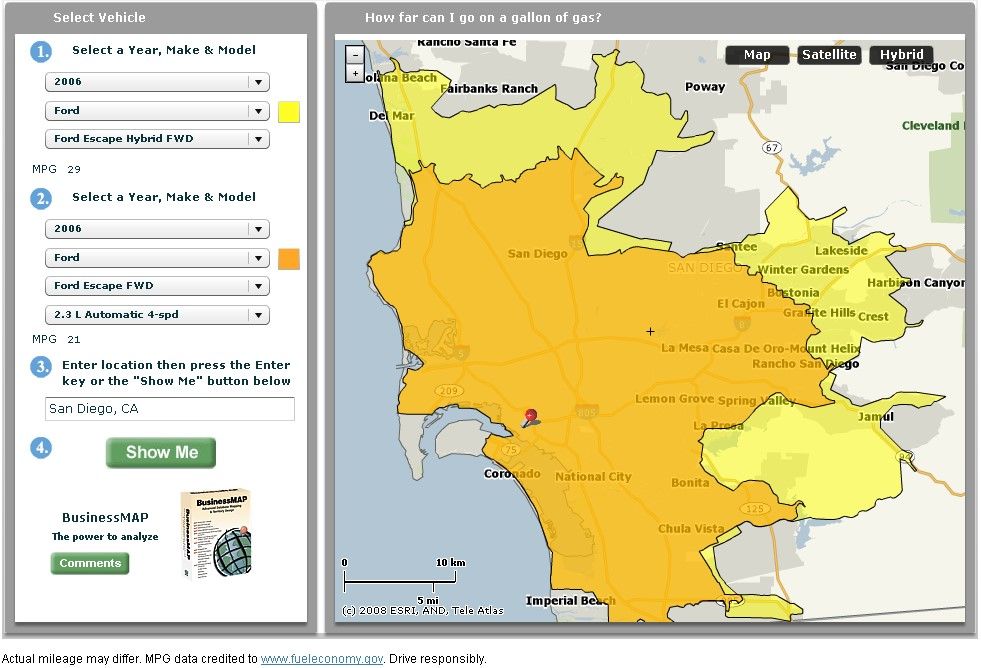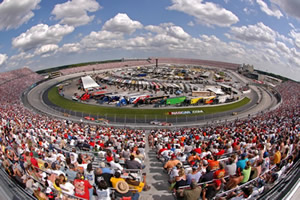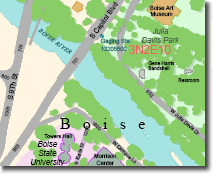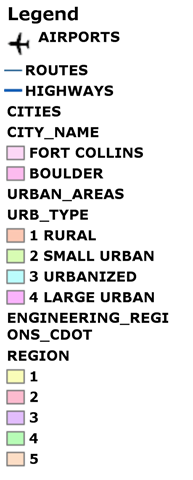Golden Guardian took place recently in California. It simulated a big quake as an opportunity for agencies to test their emergency preparedness and also to see if/how they could work together. In San Diego Caltrans District 11 was out with mobile units gathering information of “damaged” roadways and bridges that needed repair or inspection. This field collected data was transmitted up to Sacramento and loaded up into ArcGIS Server based webservices along with data from other agencies around the state. San Diego County EOC was one such agency.
Cities and counties were then able to consume these webservices in their own applications, in Common Operating Picture viewers based on the ArcGIS Server flex API, or in ArcGIS Explorer.
When the fires started breaking out in southern California (Freeway, Sayre, and Tea) before the exercise was complete, they re-tasked servers, loaded in real emergency information gathered at the fires and kept on serving it up to end users fighting the fires and making decisions on how to allocate resources.
-------------------------------------
November 17, 2008
ESRI Provides Staff and Resources for the Great Southern California ShakeOut
Images for Publication

A GIS-based common operating picture provides continuous data updates. Understanding hospital occupancy levels helps officials direct emergency medical service crews transporting new patients.
Redlands, California—At 10:00 a.m. on November 13, 2008, millions of people throughout Southern California participated in the Great Southern California ShakeOut Drill, the largest earthquake preparedness exercise in U.S. history. The drill simulated a magnitude 7.8 earthquake along the San Andreas Fault in Southern California. ESRI supported participating agencies with software, staffing, and resources used during the exercise, which modeled assessment, rescue, relief, and recovery efforts. Geographic information system (GIS) technology was used to help build an accurate, continuously updated emergency information repository; aided decision support and resource management; and enhanced multijurisdictional communication.
"We worked diligently to create a realistic exercise that helps us see where we are with our response capability in the event of a major earthquake," says John Ellison, agency technology officer and geographic information officer (GIO)/California Environmental Resources Evaluation System (CERES) director, California Resources Agency. "By upgrading to ArcGIS Server 9.3 and ArcGIS API for Flex, we have an easy-to-use Web-based viewer suitable for this purpose. We are very pleased with our GIS experience including during the exercise."
The ShakeOut kick-started a weeklong collection of exercises called the Golden Guardian 2008, held November 13–18 and involving 5,000 participants from public agencies around the state. Based on scientists' predictions of what would occur during and after a major earthquake, the simulated results included 1,800 dead, 50,000 injured, and $200 billion in damages. The goal of the drill was to test and evaluate processes, equipment, technologies, and shared workflows. Results helped determine best practices, opportunities for improvement, and potential new capabilities.
"The GIS platform developed for the Golden Guardian 2008 exercise proved to be an invaluable tool," says Paul Hardwick, GIS project manager, San Diego Homeland Security Regional Technology Center. "We were able to post pertinent information to provide situational awareness to the state emergency command center and affected communities as well as areas adjacent to the disaster. The ability to transfer information between systems and to implement server-based tasks for analysis helped make the event a success."
Multiple Emergency Operations Centers (EOCs), including California Resources Agency, deployed ESRI's Situational Awareness Bundle for the ShakeOut. The bundle provides a complete framework for geospatial intelligence analysis, visualization, and management. Users managed multiple events with the bundle's ready-to-operate hardware solution, its powerful data fusion and analysis engine, and a set of fully customizable viewers to display the affected areas. Staff also used terabytes of prerendered data including street networks, raster imagery, topographic maps, shaded relief imagery, and elevation data.
GIS helped collect and manage large volumes of diverse data including simulated damaged buildings, roads, and power and water infrastructure; affected populations; delivered supplies; and the deployment of fire, emergency medical services, law enforcement, and homeland security staff. Live data, such as weather updates, video, and Global Positioning System (GPS) information, was streamed into the GIS database and disseminated to individuals using desktop computers, mobile devices, and Web-enabled laptops. Mobile GIS helped field crews collect remotely sensed data that was automatically sent back to the comprehensive spatial database.
The ShakeOut was organized by the Earthquake Country Alliance (ECA), a partnership of earthquake professionals, emergency responders, business leaders, and community activists. The group has been planning the ShakeOut since 2006.




 Have you ever wondered where a feature class came from as you've browsed over one of your geodatabases in ArcCatalog? I think most of us have, and probably more often than we'd like to admit. In the example shown here to the left, I made these datasets a few weeks ago, and I have no idea what "GN" means, and if or how I selected, simplified, or dissolved the data.
Have you ever wondered where a feature class came from as you've browsed over one of your geodatabases in ArcCatalog? I think most of us have, and probably more often than we'd like to admit. In the example shown here to the left, I made these datasets a few weeks ago, and I have no idea what "GN" means, and if or how I selected, simplified, or dissolved the data.  We recently made some changes to the color ramp styles on Mapping Center under the
We recently made some changes to the color ramp styles on Mapping Center under the 















 Not too long ago we received a question on Ask a Cartographer about symbolizing polygons with a scalloped edge (like the old ArcInfo hardwire line symbol). Hoping to do better (scallop lines were a nice idea, but they didn't always turn out as good as I would have liked, so I rarely used them), I started experimenting with the options in representation symbology. I'm happy to report that there is a better solution.
Not too long ago we received a question on Ask a Cartographer about symbolizing polygons with a scalloped edge (like the old ArcInfo hardwire line symbol). Hoping to do better (scallop lines were a nice idea, but they didn't always turn out as good as I would have liked, so I rarely used them), I started experimenting with the options in representation symbology. I'm happy to report that there is a better solution.







